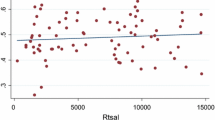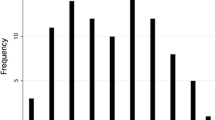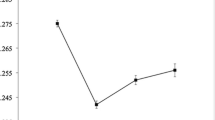Access this chapter
Tax calculation will be finalised at checkout
Purchases are for personal use only
Preview
Unable to display preview. Download preview PDF.
Similar content being viewed by others
References
Adams, J. S. (1963): Toward an Understanding on Inequity. Journal of Abnormal Psychology, 67, 422–436.
Akerlof, G. and J. Yellen (1987): Fairness and Unemployment. American Economic Review, 77 (May), 44–49.
Akerlof, G. and J. Yellen (1990): The Fair Wage-Effort Hypothesis and Unemployment. Quarterly Journal of Economics, CV (May), 255–283.
Altonji J. and C. Pierret (1997): Employer Learning and Statistical Discrimination, Working Paper presented at the University of Toronto Labor Economics Workshop, March 13.
Barbash, J. (1987): Like Nature Industrial Relations Abhors a Vacuum. Relations Industrielles/ Industrial Relations, 42, 29–35.
Barbash, J. (1989) : Equity as Function: Its Rise and Attribution in: Barbash, J. and K. Barbash (eds.): Theories and Concepts in Comparative Industrial Relations, Columbia, SC: University of South Carolina Press, 113–122.
Barbash, J. (1996): Industrial Relations as Problem Solving, in: Barbash, J. and N. M. Meltz (eds.): Theorizing in Industrial Relations: Approaches and Applications, 91–118.
Becker, B.E and M. A. Huselid (1992): The Incentive Effects of Tournament Compensation Systems. Administrative Science Quarterly, 37, 336–350.
Bloom, M. (1999): The Performance Effects of Pay Dispersion on Individuals and Organizations. Academy of Management Journal, 42, 25–40.
Brown, C. (1992): Wage Levels and Methods of Pay. Rand Journal, 23 (Autumn), 366–375.
Coleman, J. (1988): Social Capital in the Formation of Human Capital. American Journal of Sociology, 94, S95–S120.
Cowherd, D. M. and D. I. Levine (1992): Product quality and pay equality between lower-level employees and top management: An investigation of distributive justice theory. Administrative Science Quarterly, 37, 302–320.
Currie, J. and S. McConnell (1992): Firm Specific Determinants of the Real Wage. The Review of Economics and Statistics, 12, 297–304.
Drago, R and G. T. Garvey (1998): Incentives for Helping on the Job: Theory and Evidence. Journal of Labor Economics, 16, 1–25.
Dryden, K. (1983): The Game. Toronto: Totem Books.
Ehrenberg, R.G and M. L. Bognanno (1990): The Incentive Effects of Tournaments Revisited: Evidence from European PGA Tour. Industrial and Labor Relations Review, 43, 74S–88S.
Fernie, S. and D. Metcalf (1996): It’s Not What You Pay It’s the Way You Pay it and That’s What Gets Results, Centre for Economic Performance Discussion paper #295, London School of Economics.
Frank, R and P. Cook (1995): The Winner Take All Society. New York: The Free Press.
Gross, S. (1995): Compensation for Teams. American Management Association. The Hay Group.
Hamilton, B. (1997): Racial Discrimination and Professional Basketball Salaries in the 1990s. Applied Economics, 29, 287–296.
Hansen, D. G. (1997): Worker Performance and Group Incentives: A Case Study. Industrial and Labor Relations Review, 51 (October), 37–48.
Hoal, P. (1984): Introduction to Mathematical Statistics, 5th ed., New York: John Wiley & Sons.
Howard, L. and J. Miller (1993): Fair Play for Fair Pay: Estimating Pay Equity in Professional Baseball with Data Envelopment Analysis. Academy of Management Journal, 36 (August), 882–894.
Jacobs, D. (1981): Toward a Theory of Mobility and Behavior in Organizations: An Inquiry into the Consequences of Some Relationships Between Individual Performance and Organizational Success. American Journal of Sociology, 87, 684–707.
Johnston, J. (1984): Econometric Methods, 3rd edition.
Jones, J. C. H., S. Nadeau and W. D. Walsh (1997): The wages of sin: Employment and salary effects of Violence in the National Hockey League. Atlantic Economic Journal, 25 (June), 191–206.
Kaufman, B. (1993): The Origins and Evolution of the Field of Industrial Relations in the United States. Ithaca, NY: ILR Press.
Kahn, L. (1993): Managerial Quality, Team Success, and Individual Player Performance in Major League Baseball. Industrial and Labor Relations Review, 46 (April), 531–547.
Kahneman, D., J. Knetsch and R. Thaler (1986): Fairness as a Constraint on Profit Seeking: Entitlements in the Market. American Economic Review, 76 (September), 728–741.
Krashinsky, M. and H. Krashinsky (1997): Do English Canadian hockey teams discriminate against French Canadian players? Canadian Public Policy, 23, 212–216.
Kusterer, K. C. (1978): Know-how on the Job: The Important Working Knowledge of “Unskilled” Workers, Boulder, CO: Westview Press.
Laporta, R., F. Lopez-de-Silanes, A.. Schleifer and R. W. Vishny (1996): Trust in Large Organizations, National Bureau of Economic Research Working Paper No. 5864.
Lazear, E. (1989): Pay Inequality and Industrial Politics. Journal of Political Economy, 97, 561–583.
Lazear, E (1995). Personnel Economics, Cambridge: MIT Press.
Lazear, E. (1999a): Performance Pay and Productivity, Working Paper, Stanford University.
Lazear E. (1999b): Personnel Economics: Past Lessons and Future Directions. Journal of Labor Economics, 17, 199–236.
Leibenstein, H. (1973): Competition and X-Efficiency. Journal of Political Economy, 81 (May), 766–789.
Meltz, N (1993): Industrial Relations Systems as a Framework for Organizing Contributions to Industrial Relations Theory, in: Adams, R. J. and N. M. Meltz (eds.): Industrial Relations Theory: Its Nature, Scope and Pedagogy, Metuchen, NJ: The Scarecrow Press, 161–182.
Meltz, N. (1989): Industrial Relations: Balancing Efficiency and Equity, in: Barbash, J. and K. Barbash eds.): Theories and Concepts in Comparative Industrial relations, Columbia, SC: University of South Carolina press, 109–113.
Milgrom, P. and J. Roberts (1992): Economics, Organization, and Management, Englewood Cliffs, NJ: Prentice-Hall.
Milkovitch, G.T and J. Newman (1987, 1999): Compensation (2d ed., 6th ed.), Piano, TX: Business Publications.
Montgomery, J. (1991): Social Networks and Persistent Inequality in the Labor Market: Toward an Economic Analysis. American Economic Review, 81, 1408–1418.
Pelled L. H., K. M. Eisenhardt and K. R. Xin (1999): Exploring the Black Box: An Analysis of Work Group Diversity, Conflict, and Performance. Administrative Science Quarterly, 44, 1–28.
Rayton, B. A. (1996): Firm Performance and Compensation Structure: Performance Elasticities of Average Employee Compensation, unpublished working paper.
Kees, A. (1993): The Role of Fairness in Wage Determination. Journal of Labor Economics, 11, 243–252.
Roy, D. (1952): Quota Restriction and Goldbricking in a Machine Shop. American Journal of Sociology, 23, 427–442.
Spagnolo, G. (1999): Social Relations and Cooperation in Organizations. Journal of Economic Behavior and Organization, 38, 1–26.
Staudohar, P. (1997): Baseball’s Changing Salary Structure. Compensation and Working Conditions, Fall, 2–9.
Teachman, J. (1980): Analysis of Population Diversity. Sociological Methods and Research, 8, 341–362.
Author information
Authors and Affiliations
Editor information
Rights and permissions
Copyright information
© 2002 Springer Fachmedien Wiesbaden
About this chapter
Cite this chapter
Gomez, R. (2002). Salary Compression and Team Performance: Evidence from the National Hockey League. In: Albach, H., Frick, B. (eds) Sportökonomie. ZfB — Ergänzungshefte, vol 4. Gabler Verlag, Wiesbaden. https://doi.org/10.1007/978-3-663-07711-4_11
Download citation
DOI: https://doi.org/10.1007/978-3-663-07711-4_11
Publisher Name: Gabler Verlag, Wiesbaden
Print ISBN: 978-3-409-12282-5
Online ISBN: 978-3-663-07711-4
eBook Packages: Springer Book Archive




